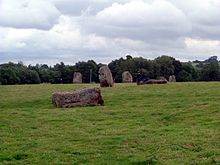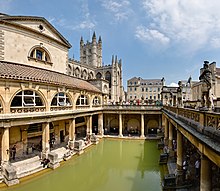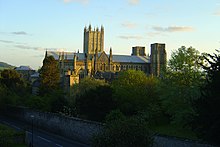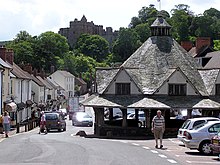History of Somerset


Following the
Expansion of the population and
Palaeolithic and Mesolithic
The
Homo sapiens sapiens, or modern man, came to Somerset during the Early Upper Palaeolithic. There is evidence of occupation of four Mendip caves 35,000 to 30,000 years ago.[6] During the Last Glacial Maximum, about 25,000 to 15,000 years ago, it is probable that Somerset was deserted as the area experienced tundra conditions. Evidence was found in Gough's Cave of deposits of human bone dating from around 12,500 years ago. The bones were defleshed and probably ritually buried though perhaps related to cannibalism being practised in the area at the time or making skull cups or storage containers.[7] Somerset was one of the first areas of future England settled following the end of Younger Dryas phase of the last ice age c. 8000 BC. Cheddar Man is the name given to the remains of a human male found in Gough's Cave in Cheddar Gorge. He is Britain's oldest complete human skeleton. The remains date from about 7150 BC, and it appears that he died a violent death. Somerset is thought to have been occupied by Mesolithic hunter-gatherers from about 6000 BCE; Mesolithic artefacts have been found in more than 70 locations. Mendip caves were used as burial places, with between 50 and 100 skeletons being found in Aveline's Hole. In the Neolithic era, from about 3500 BCE, there is evidence of farming.[8]
At the end of the
Neolithic, Bronze and Iron Ages

There is evidence of Exmoor's human occupation from Mesolithic times onwards. In the Neolithic period people started to manage animals and grow crops on farms cleared from the woodland, rather than act purely as hunter gatherers.[16] It is also likely that extraction and smelting of mineral ores to make tools, weapons, containers and ornaments in bronze and then iron started in the late Neolithic and into the Bronze and Iron Ages.[17]
The caves of the
The
Roman


Somerset was part of the Roman Empire from 47 AD to about 409 AD. However, the end was not abrupt and elements of Romanitas lingered on for perhaps a century.
Somerset was invaded from the south-east by the
The Roman invasion, and possibly the preceding period of involvement in the internal affairs of the south of England, was inspired in part by the potential of the Mendip Hills. A great deal of the attraction of the lead mines may have been the potential for the extraction of silver.[25][26]
Forts were set up at
Excavations carried out before the
In April 2010, the Frome Hoard, one of the largest-ever hoards of Roman coins discovered in Britain, was found by a metal detectorist. The hoard of 52,500 coins dated from the 3rd century AD and was found buried in a field near Frome, in a jar 14 inches (36 cm) below the surface.[31] The coins were excavated by archaeologists from the Portable Antiquities Scheme.[32]
Sub-Roman period
This is the period from about 409 AD to the start of
The Saxon advance from the east seems to have been halted by battles between the British and Saxons, for example; at the siege of Badon
There may have been effects from plague and volcanic eruption during this period as well as marine transgression into the Levels.
The language spoken during this period is thought to be
Most of what is known of the history of this period comes from Gildas's On the Ruin of Britain,[41] which is thought to have been written in Durotrigan territory, possibly at Glastonbury.
The earliest fortification of Taunton started for King Ine of Wessex and Æthelburg, in or about the year 710 AD. However, according to the Anglo-Saxon Chronicle this was destroyed 12 years later.[42]
Early Medieval

This is the period from the late 7th century (for most of Somerset) to 1066, though for part of the 10th and 11th centuries England was under Danish control. Somerset, like Dorset to the south, held the West Saxon advance from Wiltshire/Hampshire back for over a century, remaining a frontier between the Saxons and the Romano-British Celts.[43]
The
Then in the period 681–85 Centwine of Wessex conquered King Cadwaladr and "advanced as far as the sea", but it is not clear where this was. It is assumed that the Saxons occupied the rest of Somerset about this time. The Saxon rule was consolidated under King Ine, who established a fort at Taunton, demolished by his wife in 722. It is sometimes said that he built palaces at Somerton and South Petherton but this does not seem to be the case. He fought against Geraint in 710. In 705 the diocese of Sherborne was formed, taking in Wessex west of Selwood. Saxon kings granted land in Somerset by charter from the 7th century onward. The way and extent to which the Britons survived under the Saxons is a debatable matter. However, King Ine's laws make provision for Britons. Somerset originally formed part of Wessex and latter became a separate "shire". Somersetshire seems to have been formed within Wessex during the 8th century though it is not recorded as a name until later. Mints were set up at times in various places in Somerset in the Saxon period, e.g., Watchet.[46]
Somerset played an important part in defeating the spread of the Danes in the 9th century. The Anglo-Saxon Chronicle records that in 845 Alderman Eanwulf, with the men of Somersetshire (Sumorsǣte), and Bishop Ealstan, and Alderman Osric, with the men of Dorsetshire, conquered the Danish army at the mouth of the Parret. This was the first known use of the name Somersæte. The Anglo-Saxon Chronicle reports that in January 878 the King Alfred the Great fled into the marshes of Somerset from the Viking's invasion and made a fort at Athelney. From the fort Alfred was able to organize a resistance using the local militias from Somerset, Wiltshire and Hampshire.[47]
In the period before the
This period of Somerset's history is well documented, for example in the Anglo-Saxon Chronicle and Asser's Life of Alfred.[54]
Later Medieval

This is the period from 1066 to around 1500. Following the defeat of the
A good picture of the county in 1086 is given by
Reclamation of land from marsh in the Somerset Levels increased, largely under monastic influence. Crafts and industries also flourished, the Somerset woollen industry being one of the largest in England at this time.[58] "New towns" were founded in this period in Somerset, i.e. Newport, but were not successful. Coal mining on the Mendips was an important source of wealth while quarrying also took place, an example is near Bath.
The towns grew, again often by monastic instigation, during this period and fairs were started. The church was very powerful at this period, particularly
During the
In the medieval period the
Early Modern

This is the period from around 1500 to 1800. In the 1530s, the monasteries were
The
During the
In 1685, the Duke of Monmouth led the Monmouth Rebellion in which Somerset people fought against James II. The rebels landed at Lyme Regis and travelled north hoping to capture Bristol and Bath, puritan soldiers damaged the west front of Wells Cathedral, tore lead from the roof to make bullets, broke the windows, smashed the organ and the furnishings, and for a time stabled their horses in the nave.[74] They were defeated in the Battle of Sedgemoor at Westonzoyland, the last battle fought on English soil.[75] The Bloody Assizes which followed saw the losers being sentenced to death or transportation.[76]
The
The 18th century was largely one of peace and declining industrial prosperity in Somerset. The Industrial Revolution in the Midlands and Northern England spelt the end for most of Somerset's cottage industries. However, farming continued to flourish, with the Bath and West of England Agricultural Society being founded in 1777 to improve methods. John Billingsley conducted a survey of the county's agriculture in 1795 but found that methods could still be improved.[79]
Arthur Wellesley took his title, Duke of Wellington from the town of Wellington. He is commemorated on a nearby hill with a large, spotlit obelisk, known as the Wellington Monument.
In north Somerset, mining in the
Late Modern

The 19th century saw improvements to Somerset's roads with the introduction of
In 1889,
The population of Somerset has continued to grow since 1800, when it was 274,000,[25] particularly in the seaside towns such as Weston-super-Mare. Some population decline occurred earlier in the period in the villages, but this has now been reversed, and by 1951 the population of Somerset was 551,000.[25]
Around the 1860s, at the height of the iron and steel era, a
During the
Exmoor was one of the first British National Parks, designated in 1954, under the 1949
Somerset today has only two small cities,
Agriculture continues to be a major business, if no longer a major employer because of mechanisation. Light industries take place in towns such as Bridgwater and Yeovil. The towns of Taunton and Shepton Mallet manufacture cider, although the number of apple orchards has reduced.[citation needed]
In the late 19th century the boundaries of Somerset were slightly altered, but the main change came in 1974 when the county of
See also
- Somerset
- Somerset Victoria County History
- Category:Hill forts in Somerset
- Category:History of Somerset
- Geology of Somerset
- History of England
- Timeline of the Anglo-Saxon invasion and takeover of Britain.
- List of places in Somerset
- List of Sites of Special Scientific Interest in Somerset
- William Fitz Reynold
References
- ^ a b "Mendip Hills An Archaeological Survey of the Area of Outstanding Natural Beauty" (PDF). Somerset County Council Archeological Projects. Archived (PDF) from the original on 16 May 2011. Retrieved 8 November 2010.
- ^ "Westbury Cave, Westbury Quarry, Westbury". Somerset Historic Environment Record. Archived from the original on 3 October 2016. Retrieved 7 December 2007.
- ISBN 0-9535418-0-0.
- JSTOR 3032501.
- ^ Henderson, Mark (4 June 2002). "'Anglia Man' becomes earliest Ancient Briton". The Times. Archived from the original on 30 September 2015. Retrieved 29 September 2015.
- ^ The Archaeology of Somerset by C Webster and T Mayberry
- PMID 21359211.
- ^ a b "Introduction to Somerset's History". Britannia. Archived from the original on 12 November 2006. Retrieved 29 October 2006.
- ^ ISBN 0-85033-461-6.
- ^ "Somerset". Camelot Village: Britain's Heritage and History. Archived from the original on 13 June 2006. Retrieved 28 May 2006.
- ^ "The Neolithic Period: The first settlers". Somerset County Council: History of Somerset. Archived from the original on 15 August 2006. Retrieved 29 October 2006.
- ^ "The Wetlands Project Interview". Current Archaeology. 172 (Wetlands Special Issue): 136–142. February 2001.
- ^ "The day the Sweet Track was built". New Scientist, 16 June 1990. Archived from the original on 9 July 2008. Retrieved 7 October 2007.
- ISBN 0-948578-38-6.
- ^ "Post Track, Shapwick Heath". Somerset Historic Environment Record. Somerset County Council. Archived from the original on 3 October 2016. Retrieved 7 June 2010.
- S2CID 128994811.

- ^ a b "The history of Exmoor". Exmoor National Park. Archived from the original on 29 July 2013. Retrieved 6 June 2012.
- ISBN 0-8128-1505-X.
- ^ "Desk-Based Assessment of Land Adjacent to Numbers 2–10 Upper Kewstoke Road, Weston-Super-Mare, North Somerset" (PDF). Project: PJ 195. Mercian Archaeology. Retrieved 16 October 2010.[permanent dead link]
- ^ "Stanton Drew Stone Circles". English Heritage Archaeometry. Archived from the original on 30 June 2006. Retrieved 8 July 2006.
- ^ Historic England. "Monument No. 188542". Research records (formerly PastScape). Retrieved 1 January 2011.
- ^ "British Tribes". From Dot to Domesday. Archived from the original on 22 January 2008. Retrieved 2 December 2007.
- ^ "Britannia in the Ravenna Cosmography". cyberhome of Keith Fitzpatrick-Matthews. Archived from the original on 15 March 2007. Retrieved 2 December 2007.
- ^ Rajan, Amal (24 August 2007). "Around a county in 40 facts: A (very) brief history of Somerset". Independent on Sunday. Archived from the original on 14 February 2009. Retrieved 21 October 2007.
- ^ ISBN 0-340-20116-9.
- ^ a b "Romano-British Somerset". Somerset County Council: History of Somerset. Archived from the original on 17 October 2012. Retrieved 29 October 2006.
- ^ "Roman Baths Treatment Centre". Images of England. Archived from the original on 15 June 2009. Retrieved 15 November 2006.
- ^ ISBN 0-9548832-0-9.
- ^ Hucker, Ernest (1997). Chew Stoke Recalled in Old Photographs. Ernest Hucker.
- ^ "Analysis of Coin Hoards from Roman Britain". Forum Ancient Coins. Archived from the original on 22 October 2012. Retrieved 6 June 2012.
- ^ "Huge Roman coin find for hobbyist". BBC News. 8 July 2010. Retrieved 8 July 2010.
- ^ Booth, Anna (8 July 2010). "The Frome Hoard". Portable Antiquities Scheme. Archived from the original on 24 October 2011. Retrieved 8 July 2010.
- ^ "501-97". Britannia, The Anglo Saxon Chronicles. Archived from the original on 10 November 2006. Retrieved 29 October 2006.
- ^ The Anglo-Saxon Chronicle, 501–97 AD Archived 10 November 2006 at the Wayback Machine.
- ^ The Anglo-Saxon Chronicle, 645–56 AD Archived 12 December 2007 at the Wayback Machine
- ^ The Anglo-Saxon Chronicle, 658–75 AD Archived 12 December 2007 at the Wayback Machine
- ^ The Victoria History of the County of Somerset, Vol 1 (1906)History of Somerset
- ^ "Roman Times". Britannia. Archived from the original on 12 November 2006. Retrieved 29 October 2006.
- ISBN 1-902007-01-8.
- ISBN 1-85182-140-6.
- ^ "Gildas and The History of the Britons". Latin Writings in England to the Time of Alfred. Archived from the original on 28 August 2006. Retrieved 29 October 2006.
- ^ Charles Oman. "History of Taunton Castle in Somerset". Britannia castles. Archived from the original on 31 May 2008. Retrieved 21 November 2007.
- ^ Lewis, Brenda Ralph; Ford, David Nash. "Narrative History of Saxon Somerset". Britania. Archived from the original on 11 May 2008. Retrieved 21 October 2007.
- ^ "Saxon Somerset". Somerset County Council: History of Somerset. Archived from the original on 25 September 2006. Retrieved 29 October 2006.
- ^ "Timeline: 642-774". Anglo-Saxons.net. Retrieved 6 August 2017.
- ^ Gathercole, Clare. "An archaeological assessment of Watchet" (PDF). English Heritage Extensive Urban Survey. Somerset County Council. Retrieved 5 July 2017.
- ^ Plummer, Charles (1911). . In Chisholm, Hugh (ed.). Encyclopædia Britannica. Vol. 1 (11th ed.). Cambridge University Press. pp. 582–584.
- ^ a b Farr, Grahame (1954). Somerset Harbours. London: Christopher Johnson. pp. 125–137.
- ^ Greswell, W. H. P. (1922) Dumnonia and the Valley of the Parret
- ^ "Replicas of the Alfred Jewel". The Anglo Saxon Index, Trinity College, Cambridge. Archived from the original on 2 November 2007. Retrieved 18 September 2007.
- ^ "Local History". North Petherton. Archived from the original on 30 June 2007. Retrieved 19 November 2007.
- ^ Rahtz, Phillip. "The Saxon and Medieval Palaces at Cheddar, Somerset-an Interim Report of Excavations in I 960-62" (PDF). Archaeology Data Service. Archived from the original (PDF) on 10 April 2008. Retrieved 31 March 2008.
- ^ Chisholm, Hugh, ed. (1911). . Encyclopædia Britannica. Vol. 25 (11th ed.). Cambridge University Press. p. 390.
- ISBN 0-14-044409-2.
- ISBN 0-7524-1941-2.
- ^ "The Shire and the Hundred". Somerset County Council: History of Somerset. Archived from the original on 25 September 2006. Retrieved 29 October 2006.
- ^ "Domesday Somerset". Somerset County Council: History of Somerset. Archived from the original on 25 September 2006. Retrieved 29 October 2006.
- ^ "Saxon Times". Britannia. Archived from the original on 12 November 2006. Retrieved 29 October 2006.
- ISBN 1-902007-01-8.
- ^ "Bridgwater Castle, Bridgwater". Somerset Historic Environment Record. Somerset County Council. Archived from the original on 3 October 2016. Retrieved 12 October 2008.
- .
- ISBN 1-86077-363-X. Chapter 8: "The Medieval Port of Bridgwater".
- ISBN 0-900131-15-2.
- ^ ISBN 978-0-7509-01925.
- ISBN 0-900131-15-2.
- ISBN 0-7509-0518-2.
- ^ Bryant, Edward; Haslett, Simon (2002). "Was the AD 1607 coastal flooding event in the Severn estuary and Bristol channel due to a Tsunami?". Archaeology in the Severn Estuary. 13: 163–167. Archived from the original on 14 November 2013. Retrieved 27 March 2013.
- ^ Bryant, Edward; Haslett, Simon (2004). "The AD 1607 Coastal Flood in the Bristol Channel and Severn Estuary: Historical Records from Devon and Cornwall (UK)". Archaeology in the Severn Estuary. 15: 81–89. Archived from the original on 24 April 2012. Retrieved 27 March 2013.
- ^ "Historic Buildings of Shepton Mallet". Shepton Mallet Town Council. Archived from the original on 18 January 2012. Retrieved 30 August 2007.
- ISBN 0-9511470-2-1. Also in updated form as a CD-ROM (2001), see "Shepton Mallet Prison: 390 years of prison regime" Archived 20 November 2008 at the Wayback Machine
- ^ Rodgers, Colonel H.C.B. (1968). Battles and Generals of the Civil Wars. Seeley Service & Co.
- ^ "Taunton's History". Taunton Town Centre!. Archived from the original on 3 June 2007. Retrieved 21 November 2007.
- ^ "The Civil War in Somerset". Somerset County Council: History of Somerset. Archived from the original on 25 September 2006. Retrieved 29 October 2006.
- ^ "The Monmouth rebellion and the bloody assize". Somerset County Council. Archived from the original on 29 August 2007. Retrieved 11 February 2008.
- ^ "History of Bridgwater". Bridgwater. Archived from the original on 12 November 2007. Retrieved 21 October 2007.
- ^ "Tudor & Stuart Times". Britannia. Archived from the original on 12 November 2006. Retrieved 29 October 2006.
- ISBN 1-902007-01-8.
- ^ "History". Street Society. Archived from the original on 21 November 2008. Retrieved 14 November 2010.
- ^ (esq), John Billingsley; Britain), Board of Agriculture (Great (1798). General View of the Agriculture of the County of Somerset. Retrieved 10 October 2007.
- ^ "Rivers and Canals". Somerset County Council: History of Somerset. Archived from the original on 8 September 2012. Retrieved 29 October 2006.
- ISBN 0-415-19399-0.
- ^ "Chard was there first". The Daily Telegraph. 7 October 2006. Archived from the original on 29 October 2006. Retrieved 17 October 2008.
- ^ "North Petherton". British History Online. Archived from the original on 25 May 2011. Retrieved 19 November 2007.
- ISBN 978-1-85260-049-5.
- ISBN 978-0-7110-2063-4.
- ISBN 978-1-903599-13-6.
- ^ ISBN 978-0-7524-2240-4.
- ^ "Albright and Wilson Ltd" (PDF). ICI. 1960. Archived (PDF) from the original on 15 August 2009. Retrieved 3 December 2009.
- ^ "City of Bristol (Portishead Docks) Act". Office of Public Sector Information. 1992. Archived from the original on 25 September 2008. Retrieved 1 December 2009.
- ISBN 1-85074-718-0
- ISBN 0-521-07486-X.
- ^ "Taunton Stop Line". Pillboxes Somerset. Archived from the original on 28 October 2007. Retrieved 25 October 2007.
- ISBN 1-85306-864-0.
- ^ "The Mendip Society website". Archived from the original on 5 February 2007. Retrieved 17 February 2007.
- ^ "Hinkley A: 1965". BBC Somerset. BBC. Archived from the original on 18 July 2006. Retrieved 5 July 2008.
- ^ "New dawn for UK nuclear power". World Nuclear News. 24 September 2008. Archived from the original on 25 September 2008. Retrieved 25 September 2008.
- ^ "Nuclear energy: British Energy facts". The Daily Telegraph. London. 24 September 2008. Archived from the original on 27 September 2008. Retrieved 25 September 2008.
- ^ "Local Government since 1800". Somerset County Council: History of Somerset. Archived from the original on 25 September 2006. Retrieved 29 October 2006.
- ^ "Proposals for future unitary structures: Stakeholder consultation". Communities and Local Government. Archived from the original on 9 December 2007. Retrieved 29 June 2007.
- ^ a b "Unitary authority plan rejected". BBC. 25 July 2007. Retrieved 10 July 2010.
Further reading
- Samuel Tymms (1832). "Somersetshire". Western Circuit. The Family Topographer: Being a Compendious Account of the ... Counties of England. Vol. 2. London: J.B. Nichols and Son. OCLC 2127940.
- Armitage, Joseph Armitage (1921).. Humphrey Milford, Oxford University Press.
- Porter, H.M. (1967). The Saxon Conquest of Somerset and Devon. Bath, Somerset: James Brodie Ltd.
- Underdown, David (1973). Somerset in the Civil War and Interregnum. Newton Abbot: David & Charles. ISBN 0-7153-5805-7.
External links
- Aspects of Somerset History
- Victoria County History of Somerset
- Somerset Archives and Record Service
- Somerset Archaeology and Natural History Service
- The Aggregate Landscape of Somerset: Predicting the Archaeological Resource
- The history and antiquities of Somersetshire, vol. 1 (1836–38)
- The history and antiquities of Somersetshire, vol. 2 (1839)
- "Somerset", Historical Directories, UK: University of Leicester, archived from the original on 5 July 2013, retrieved 11 September 2013
